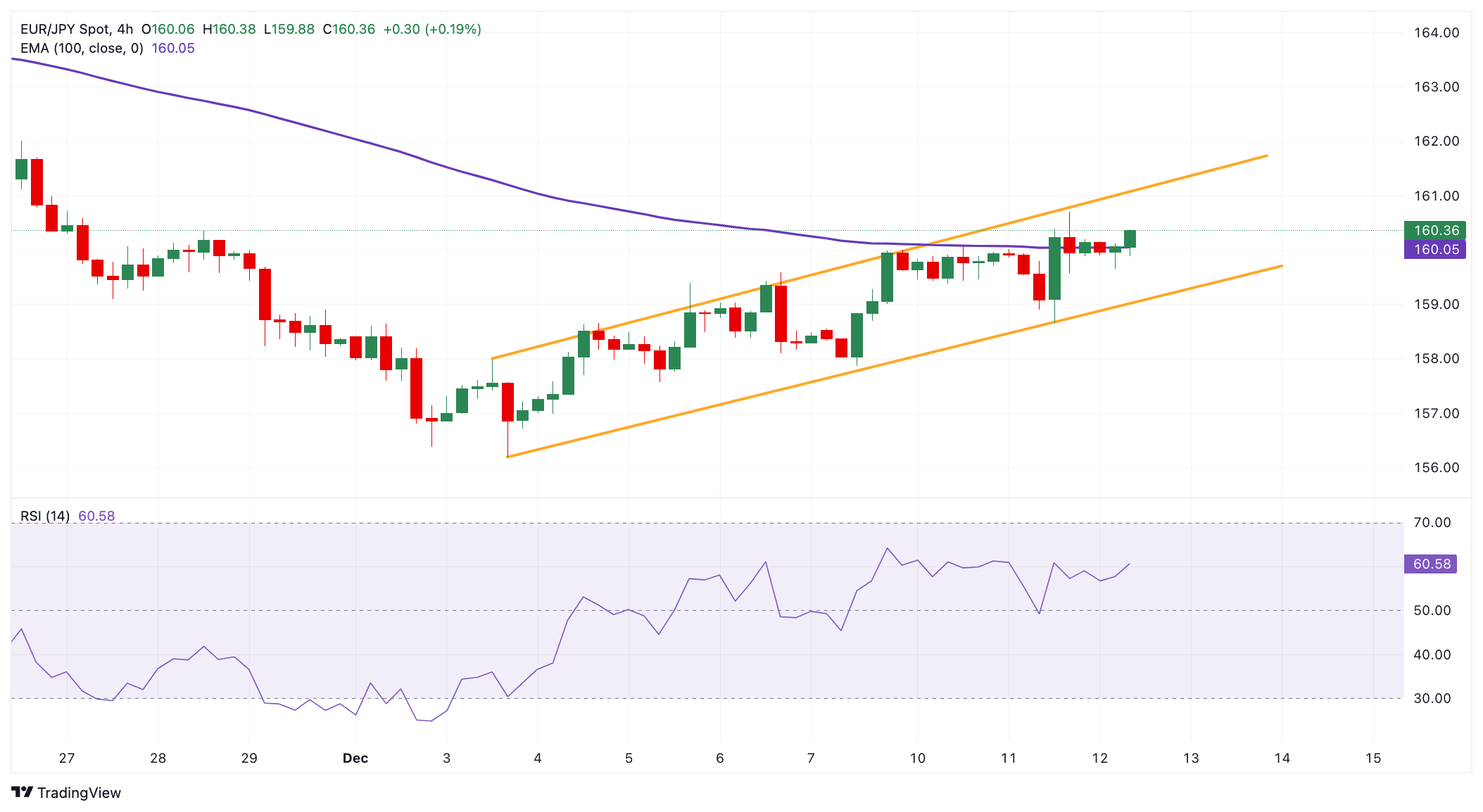- EUR/JPY extends the rally to near 160.35 in Thursday’s early European session, adding 0.15% on the day.
- The cross resumes an uptrend above the key 100-period EMA with the bullish RSI indicator.
- The immediate resistance level is located at 160.70; the crucial support level emerges at the 160.00 psychological level.
The EUR/JPY cross trades in positive territory for the fourth consecutive day around 160.35 during the early European session on Thursday. The Japanese Yen (JPY) weakens after Reuters reported on Thursday that the Bank of Japan (BoJ) is considering keeping interest rates steady at its December meeting next week. A source said, “Policymakers prefer to spend more time scrutinising overseas risks and clues on next year's wage outlook.” Later on Thursday, investors will closely monitor the European Central Bank (ECB) interest rate decision.
Technically, EUR/JPY resumes its uptrend on the 4-hour chart as the price crosses above the key 100-period Exponential Moving Average (EMA). The upward momentum is supported by the Relative Strength Index (RSI), which stands above the midline near 59.45, supporting the buyers in the near term.
The first upside barrier for the cross emerges at 160.70, the high of December 11. Sustained trading above this level could pave the way to 161.10, the upper boundary of the ascending trend channel. The next potential resistance level is seen at 162.00, representing the high of November 26 and the round figure.
On the other hand, a breach of the 160.00 psychological level could drag the cross lower to 159.10, the lower limit of the trend channel. Any follow-through selling below the mentioned level could see a drop to 158.65, the low of December 11.
EUR/JPY 4-hour chart
Euro FAQs
The Euro is the currency for the 20 European Union countries that belong to the Eurozone. It is the second most heavily traded currency in the world behind the US Dollar. In 2022, it accounted for 31% of all foreign exchange transactions, with an average daily turnover of over $2.2 trillion a day, according to data from the Bank of International Settlements. EUR/USD is the most heavily traded currency pair in the world, accounting for an estimated 30% of all transactions, followed by EUR/JPY (4%), EUR/GBP (3%) and EUR/AUD (2%).
Information on these pages contains forward-looking statements that involve risks and uncertainties. Markets and instruments profiled on this page are for informational purposes only and should not in any way come across as a recommendation to buy or sell in these assets. You should do your own thorough research before making any investment decisions. FXStreet does not in any way guarantee that this information is free from mistakes, errors, or material misstatements. It also does not guarantee that this information is of a timely nature. Investing in Open Markets involves a great deal of risk, including the loss of all or a portion of your investment, as well as emotional distress. All risks, losses and costs associated with investing, including total loss of principal, are your responsibility. The views and opinions expressed in this article are those of the authors and do not necessarily reflect the official policy or position of FXStreet nor its advertisers. The author will not be held responsible for information that is found at the end of links posted on this page.
If not otherwise explicitly mentioned in the body of the article, at the time of writing, the author has no position in any stock mentioned in this article and no business relationship with any company mentioned. The author has not received compensation for writing this article, other than from FXStreet.
FXStreet and the author do not provide personalized recommendations. The author makes no representations as to the accuracy, completeness, or suitability of this information. FXStreet and the author will not be liable for any errors, omissions or any losses, injuries or damages arising from this information and its display or use. Errors and omissions excepted.
The author and FXStreet are not registered investment advisors and nothing in this article is intended to be investment advice.
Recommended content
Editors’ Picks

EUR/USD drops below 1.0800 on Trump's 'Liberation Day'
EUR/USD is back in the red below 1.0800 in the early European morning on Wednesday as investors rush for the safe-haven US Dollar, aniticpating US President Donald Trump’s long-threatened “reciprocal” tariffs package, due to be announced at 20:00 GMT.

GBP/USD trades with caution above 1.2900, awaits Trump’s tariffs reveal
GBP/USD is trading with caution above 1.2900 early Wednesday, struggles to capitalize on the overnight bounce amid resugent haven demand for the US Dollar. Traders remain wary heading into the US 'reciprocal tariffs' announcement on "Liberation Day' at 20:00 GMT.

Gold price remains close to record high amid concerns over Trump’s reciprocal tariffs
Gold price regains positive traction amid concerns about Trump’s aggressive trade policies. Fed rate cut bets keep the USD bulls on the defensive and further benefiting the XAU/USD pair. A broadly stable risk sentiment might cap gains ahead of Trump’s tariffs announcement.

Bitcoin, Ethereum and Ripple brace for volatility amid Trump’s ‘Liberation Day’
Bitcoin price faces a slight rejection around its $85,000 resistance level on Wednesday after recovering 3.16% the previous day. Ripple follows BTC as it falls below its critical level, indicating weakness and a correction on the horizon.

Is the US economy headed for a recession?
Leading economists say a recession is more likely than originally expected. With new tariffs set to be launched on April 2, investors and economists are growing more concerned about an economic slowdown or recession.

The Best brokers to trade EUR/USD
SPONSORED Discover the top brokers for trading EUR/USD in 2025. Our list features brokers with competitive spreads, fast execution, and powerful platforms. Whether you're a beginner or an expert, find the right partner to navigate the dynamic Forex market.


